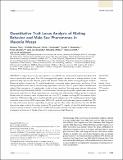Files in this item
Quantitative trait locus analysis of mating behavior and male sex pheromones in Nasonia wasps
Item metadata
| dc.contributor.author | Diao, Wenwen | |
| dc.contributor.author | Mousset, Mathilde | |
| dc.contributor.author | Horsburgh, Gavin J. | |
| dc.contributor.author | Vermeulen, Cornelis J. | |
| dc.contributor.author | Johannes, Frank | |
| dc.contributor.author | van de Zande, Louis | |
| dc.contributor.author | Ritchie, Michael G. | |
| dc.contributor.author | Schmitt, Thomas | |
| dc.contributor.author | Beukeboom, Leo W. | |
| dc.date.accessioned | 2016-06-21T14:30:04Z | |
| dc.date.available | 2016-06-21T14:30:04Z | |
| dc.date.issued | 2016-06-01 | |
| dc.identifier | 243564663 | |
| dc.identifier | b6d0f676-b709-44d5-a8ef-5e82ddd61404 | |
| dc.identifier | 84973102919 | |
| dc.identifier | 000377821600007 | |
| dc.identifier.citation | Diao , W , Mousset , M , Horsburgh , G J , Vermeulen , C J , Johannes , F , van de Zande , L , Ritchie , M G , Schmitt , T & Beukeboom , L W 2016 , ' Quantitative trait locus analysis of mating behavior and male sex pheromones in Nasonia wasps ' , G3: Genes, Genomes, Genetics , vol. 6 , no. 6 , pp. 1549-1562 . https://doi.org/10.1534/g3.116.029074 | en |
| dc.identifier.issn | 2160-1836 | |
| dc.identifier.other | RIS: urn:DEF9B41D9EDD6E48E360F63DD85157C8 | |
| dc.identifier.other | ORCID: /0000-0001-7913-8675/work/46761127 | |
| dc.identifier.uri | https://hdl.handle.net/10023/9026 | |
| dc.description | SNP genotyping was supported by the Natural Environment Research Council (NERC), UK, and performed at NERC Bio-molecular Analysis Facility (NBAF) at the University of Sheffield with project number NBAF653. This study was funded by Marie Curie Initial Training Network “Understanding the evolutionary origin of biological diversity” (ITN-2008-213780 SPECIATION). F.J. acknowledges support from the Technische Universität München – Institute for Advanced Study, funded by the German Excellence Initiative and the European Union Seventh Framework Program under grant agreement no. 291763. | en |
| dc.description.abstract | A major focus in speciation genetics is to identify the chromosomal regions and genes that reduce hybridization and gene flow. We investigated the genetic architecture of mating behavior in the parasitoid wasp species pair Nasonia giraulti and Nasonia oneida that exhibit strong prezygotic isolation. Behavioral analysis showed that N. oneida females had consistently higher latency times, and broke off the mating sequence more often in the mounting stage when confronted with N. giraulti males compared with males of their own species. N. oneida males produce a lower quantity of the long-range male sex pheromone (4R,5S)-5-hydroxy-4-decanolide (RS-HDL). Crosses between the two species yielded hybrid males with various pheromone quantities, and these males were used in mating trials with females of either species to measure female mate discrimination rates. A quantitative trait locus (QTL) analysis involving 475 recombinant hybrid males (F2), 2148 reciprocally backcrossed females (F3), and a linkage map of 52 equally spaced neutral single nucleotide polymorphism (SNP) markers plus SNPs in 40 candidate mating behavior genes revealed four QTL for male pheromone amount, depending on partner species. Our results demonstrate that the RS-HDL pheromone plays a role in the mating system of N. giraulti and N. oneida, but also that additional communication cues are involved in mate choice. No QTL were found for female mate discrimination, which points at a polygenic architecture of female choice with strong environmental influences. | |
| dc.format.extent | 14 | |
| dc.format.extent | 1580170 | |
| dc.language.iso | eng | |
| dc.relation.ispartof | G3: Genes, Genomes, Genetics | en |
| dc.subject | Nasonia courtship | en |
| dc.subject | Female choice | en |
| dc.subject | Sex pheromone | en |
| dc.subject | QTL analysis | en |
| dc.subject | Speciation | en |
| dc.subject | QH301 Biology | en |
| dc.subject.lcc | QH301 | en |
| dc.title | Quantitative trait locus analysis of mating behavior and male sex pheromones in Nasonia wasps | en |
| dc.type | Journal article | en |
| dc.contributor.sponsor | European Commission | en |
| dc.contributor.institution | University of St Andrews. School of Biology | en |
| dc.contributor.institution | University of St Andrews. Centre for Biological Diversity | en |
| dc.contributor.institution | University of St Andrews. Institute of Behavioural and Neural Sciences | en |
| dc.identifier.doi | 10.1534/g3.116.029074 | |
| dc.description.status | Peer reviewed | en |
| dc.identifier.grantnumber | 213780 | en |
This item appears in the following Collection(s)
Items in the St Andrews Research Repository are protected by copyright, with all rights reserved, unless otherwise indicated.

